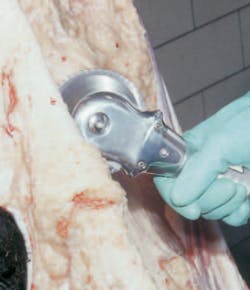Few of us like to dwell on what happens during the transition from beef cattle in the pasture to roast beef on the plate, but meat processing is still an important American industry — vastly changed today from the sledgehammer days when Chicago was the "Hog Butcher for the World." Jarvis Products Corp., Middletown, Conn., designs and manufactures a wide range of hydraulic and pneumatic devices that make meat processing less physically demanding, safer, and more efficient.
One Jarvis product is the JCIIIA pneumatically powered dehider or skinning knife. In order to separate the hide from the carcass, it is necessary to cut the membrane between the hide and the fat layer over the meat. This cutting typically is performed while the carcass is suspended on a conveyor moving at the rate of 300 to 400 carcasses per hour. As many as 18 dehiding workers are assigned to this conveyor line; each is responsible for separating a small area of the hide.
Because the hide is a valuable byproduct — for leather production — one of the goals of this process is to separate the hide from the carcass without damaging the hide with scores and cuts. Of course, another goal is to avoid trimming valuable meat from the carcass along with the hide.
Originally, straight-edged knives did the skinning. Damaged hides and wasted meat were common from all but the most skilled operators, and fatigue was unavoidable. Electric rotary dehiders were an early attempt to make this job easier, but they were cumbersome to operate and maneuver, and even more tiring because of their weight.
Pneumatics answers the call
To eliminate the weight of the electrical insulation, Jarvis investigated pneumatics as a way to power more compact and easily maneuverable rotary tools for dehiding. It experimented with commercially available air motors, but found that they used a lot of air and had to be operated at 90 psi to generate the power required to keep up with line rates. In addition, not all of Jarvis' customers had compressor capacity to maintain this pressure at multiple stations.
Jarvis then developed its own air motor — capable of efficiently meeting the power requirements while consuming only 12 cfm at 45 psi. The Jarvis motor has five fiber/resin-composite vanes, weighs 2.9 lb, and is rated at 0.55 hp. Overall length is 13 in. A single trigger on the handle starts and stops the motor (modulation is un-necessary in this application). Jarvis definitely recommends lubricated air for the JCIIIA's motor. It provides an FRL combination that includes an oil-mist lubricator with the dehider.
Jarvis discovered that oscillating blades are less prone to cut into hides, making the tool more forgiving to inexperienced operators. To accomplish this, the air motor drives an eccentric shaft via a spiral-bevel gear set. The shaft in turn rotates two drive levers that cause the blade set to oscillate, and a counterbalance minimizes vibration. The result is a shearing action between teeth on the blades. The blades' cutting speed is 6500 to 7000 oscillations per minute.
The dehider is offered in 45- or 90-psi versions. Energy-conscious customers want to run the knives at the lower inlet-air pressure, but if they do not enforce the 45-psi limit, the tools can be over-driven — causing excessive wear and maintenance. If the customer knows he cannot control the inlet pressure (or in reality cannot control the operators that use the tool), Jarvis offers him the 90-psi model, which has an integral restrictor that prevents the tool from running too fast.
Contact Jarvis Products at (860) 347-7271 or visit www.jarvisproducts.com.



